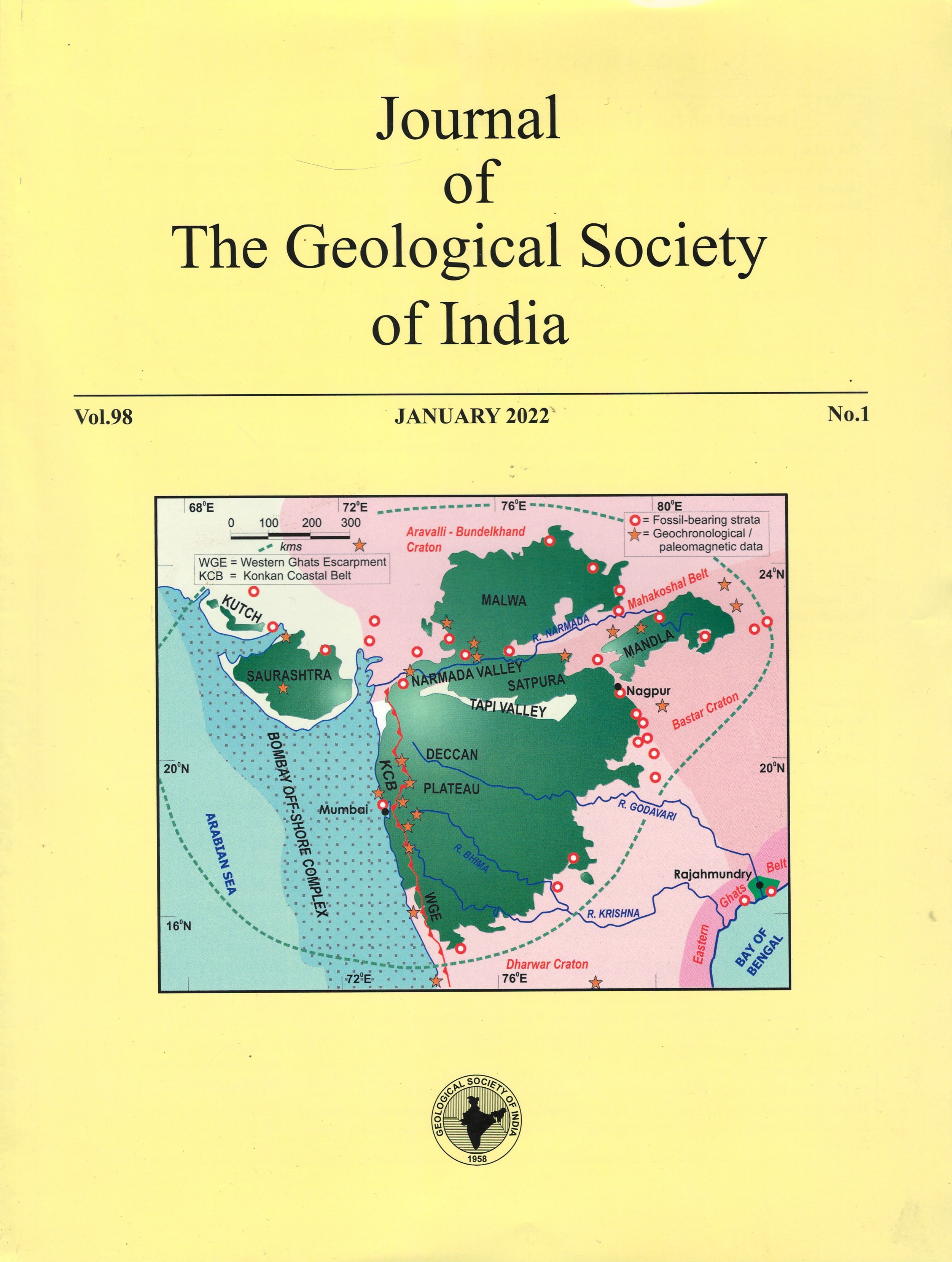Nature of Mineralizing Fluid in Paleoproterozoic Dolomite Hosted Talc Deposits, Cuddapah Basin, India
DOI:
https://doi.org/10.1007/s12594-022-1922-4Keywords:
No KeywordsAbstract
Dolomite hosted talc deposits of the Vempalle Formation (VF), Cuddapah basin, Andhra Pradesh produces nearly 6% of total talc demand of India. The strata bound talc zones extending over kilometers along strike have tabular geometry and are concordant with the stratification and primary depositional contacts, though sometimes the talc bodies locally cross-cut the stratification. Field and petrographic evidences suggest that the strata-bound talc deposit, located at the flank of the basin, was formed by replacement of platformal carbonate sequences of the passive margin (stromatolitic dolomite), preserving the primary texture and structure of the host. Lack of anomalous concentrations of V, Fe, Ni, Cr and Co; depletion of Ta, Hf, Zr and Th and Ni, Cu, Pb, Zn in the talc and talc bearing dolomites may be indicative of the absence of magmatic and/or metamorphic source for the mineralization fluid. The igneous intrusions within the Vempalle Formation (VF) – earlier thought to be the source of mineralization fluid – thus are neither coeval with talc mineralization nor they acted as the heat source. Furthermore, depletion of REE, Al3+, K+, Na and Sr in the talc and talc bearing dolomites suggest that the mineralizing fluid was probably evolved from Paleoproterozoic ocean water that was super-saturated with respect to talc and had higher dissolved silica concentration. This evolved fluid source can also explain the supply and sustenance of large volume of water needed for the talcification of the host dolomite.
Downloads
Metrics
Issue
Section
Downloads
Published
How to Cite
References
Anderson, D. L., Mogk, D. W. and Childs, J. F. (1990) Petrogenesis and timing of talc formation in the Ruby Range, southwestern Montana. Econ. Geol., v.85, pp.585-600.
Azmy, K., Veizer, J., Misi, A., de Oliveira, T.F., Sanches, A.L. and Dardenne, M.A. (2001) Dolomitization and isotope stratigraphy of the Vazante Formation, São Francisco Basin, Brazil. Precambrian Res., v.112, pp.303– 329.
Banerjee, A., Slowakiewicz, M., Majumder, T., Khan, S., Patranabis-Deb, S., Tucker, M.E. and Saha, D. (2019) A Palaeoproterozoic dolomite (Vempalle Formation, Cuddapah Basin, India) showing Phanerozoic-type dolomitisation. Precambrian Res., v.328, pp.9-26.
Bau, M. and Dulski, P. (1996) Distribution of Yttrium and Rare-Earth Elements in the Penge and Kuruman Iron Formations, Transvaal Supergroup, South Africa. Precambrian Res., v.79, pp.37- 55.
Bellanca, A., Masetti, D. and Neri, R. (1997) Rare earth elements in limestone/ marlstone couplets from the Albian-Cenomanian Cismon section (Venetian region, northern Italy): assessing REE sensitivity to environmental changes. Chemical Geol., v.141, pp.141–152
Blount, A.M. and Vassiliou, A.H. (1980) The Mineralogy and Origin of the Talc Deposits near Winterboro, Alabama. Econ. Geol., v.75, pp.107-116. Borreswara Rao, C. (1957) Genesis of steatite in Mutchukota area, Anantapur district, Andhra state. Quart. Jour. Geol. Min. Metall. Soc. India, v.29, pp.45-49.
Borreswara Rao, C. (1963) Thermal analysis of altered rocks from Vempalle limestone belt, Cuddapah System. Curr. Sci., v.8, pp.358-359.
Budd, D.A. (1997) Cenozoic dolomites of carbonate islands: their attributes and origin. Earth Sci. Rev., v.42, pp.1–47.
Howe, H. and Pawley, A.R. (2019) The effect of solid solution on the stability of talc and 10-Å phase. Contrib. Mineral. Petrol., v.174, doi:10.1007/ s00410-019-1616-0
Indian Minerals Yearbook. (2019) (Part III: Mineral Reviews) 58th Edition Minor minerals 30.22 talc, soapstone and steatite (advance release). Government of India, Ministry of Mines, Indian Bereau of Mines. 30-22- 1-30-22-4
Joshi, P. and Sharma, R. (2014) Fluid inclusion and geochemical signatures of the talc deposits in Kanda area, Kumaun, India: implications for genesis of carbonate hosted talc deposits in Lesser Himalaya. Carbonates and Evaporites, doi:10.1007/s13146-014-0196-3
Maliva, R.G., Knoll, A.H. and Simonson, B.M. (2005) Secular change in Precambrian silica cycle: insights from chert petrology. Geol. Soc. Amer. Bull., v.117, pp.835-845.

 Amlan Banerjee
Amlan Banerjee






